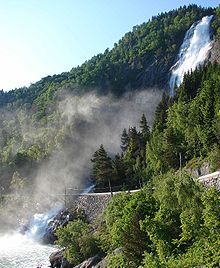
Back Norwegische Landschaftsrouten German Rutas Turísticas Nacionales en Noruega Spanish Routes nationales touristiques de Norvège French Nationale toeristenweg Dutch Nasjonal turistveg NN Nasjonal turistvei NB Norsk nationell turistväg Swedish Tuyến đường Du lịch Quốc gia tại Na Uy Vietnamese

National Tourist Routes (Norwegian: Nasjonale turistveger) are eighteen highways in Norway designated by the Norwegian Public Roads Administration for their picturesque scenery and tourist-friendly infrastructure, such as rest stops and viewpoints.[1] The routes cover 1,850 kilometres (1,150 mi) and are located along the West Coast, in Northern Norway and in the mountains of Southern Norway.[2] The authorities have coordinated the establishment of accommodation, cultural activities, dining, sale of local arts and crafts, and natural experiences along the tourist roads.[2] The overall goal of the project is to increase tourism in the rural areas through which the roads run.[3]
The project started in 1994 and was initially limited to Sognefjellsvegen, Gamle Strynefjellsveg, Hardanger and the Helgeland Coast Route. These were officially designated National Tourist Routes in 1997, and, the following year, the Storting decided to expand the project. Municipalities were asked to nominate roads, resulting in 52 nominees covering 8,000 kilometres (5,000 mi). Eighteen routes were selected in 2004,[4] with the goal of completing the necessary upgrades and officially opening them as National Tourist Routes by 2015. The upgrades are estimated to cost 800 million Norwegian kroner (ca. €100 million).[2] This includes building resting places, parking lots, viewpoints, and clearing vegetation. The Public Roads Administration's aim is that use of design will enhance the visitors' experience.[3] While most of the architecture has been designed by young Norwegians, French-American Louise Bourgeois and Swiss Peter Zumthor have designed stops in Varanger and Ryfylke.[1] Artworks have been installed at selected viewpoints, including one by American fine artist Mark Dion.[3] All routes were signposted and officially designated by 2012.[3][5] That year, the architecture magazine Topos awarded the project a special prize for its use of architecture, and particularly noted that it was a public-sector focus on aesthetic design.[3][6]
Two routes constitute part of the International E-road network: E10 through Lofoten and E75 through Varanger.[7][8] Mountain pass roads, such as Sognefjellsvegen, Valdresflye and Trollstigen, are closed during winter.[3][9][10][11] Both sections of the Helgeland Coast Route have two ferries in them,[12][13] while there is one ferry on Geiranger–Trollstigen[11] and three each on the routes through Ryfylke and Hardanger.[14][15] The Andøya and Senja routes are connected via the Andenes–Gryllefjord Ferry.[16]
- ^ a b "Om nasjonale turistveger" (in Norwegian). Norwegian Public Roads Administration. Archived from the original on 14 September 2011. Retrieved 5 October 2011.
- ^ a b c Fonbæk, Dag (3 August 2008). "Her er de norske "Postkortveiene"". Verdens Gang (in Norwegian). Archived from the original on 18 November 2011. Retrieved 5 October 2011.
- ^ a b c d e f Schäfer, Robert (6 August 2012). "The Norwegian National Tourist Routes". Topos (in Norwegian). Archived from the original on 3 November 2012. Retrieved 26 October 2012.
- ^ "Historikk" (in Norwegian). Norwegian Public Roads Administration. Archived from the original on 14 September 2011. Retrieved 5 October 2011.
- ^ Tanstad, Bent (1 July 2012). "Dette er dei vakraste vegane i landet" (in Norwegian). Norwegian Broadcasting Corporation. Archived from the original on 9 November 2012. Retrieved 24 October 2012.
- ^ Lorentsen, Hilde Mangstad (27 September 2012). "Ny internasjonal arkitekturpris til Norske turistveier" (in Norwegian). Norwegian Broadcasting Corporation. Archived from the original on 31 October 2012. Retrieved 26 October 2012.
- ^ "Nasjonal turistveg Lofoten" (in Norwegian). Norwegian Public Roads Administration. Archived from the original on 5 October 2011. Retrieved 5 October 2011.
- ^ "Nasjonal turistveg Varanger" (in Norwegian). Norwegian Public Roads Administration. Archived from the original on 5 October 2011. Retrieved 5 October 2011.
- ^ "Sognefjellet". Norwegian Public Roads Administration. Archived from the original on 8 October 2011. Retrieved 5 October 2011.
- ^ "Valdresflye". Norwegian Public Roads Administration. Archived from the original on 8 October 2011. Retrieved 5 October 2011.
- ^ a b "Geiranger–Trollstigen". Norwegian Public Roads Administration. Archived from the original on 2 April 2011. Retrieved 5 October 2011.
- ^ "Helgelandskysten sør". Norwegian Public Roads Administration. Archived from the original on 7 October 2011. Retrieved 5 October 2011.
- ^ "Helgelandskysten nord". Norwegian Public Roads Administration. Archived from the original on 30 September 2011. Retrieved 5 October 2011.
- ^ "Ryfylke". Norwegian Public Roads Administration. Archived from the original on 8 October 2011. Retrieved 5 October 2011.
- ^ "Hardanger". Norwegian Public Roads Administration. Archived from the original on 8 October 2011. Retrieved 5 October 2011.
- ^ "Nasjonal turistveg Andøya" (in Norwegian). Norwegian Public Roads Administration. Archived from the original on 5 October 2011. Retrieved 5 October 2011.